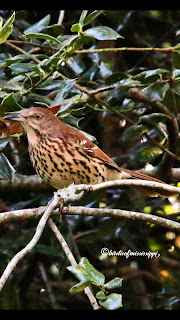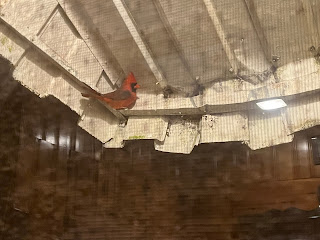BIRD NESTS - 5/27/20
BIRD NESTS
BY: PEGGY WILLIAMS AKA Birdie of Mississippi
Every day I look out my kitchen window and see squirrels eating away at my expensive black oil sunflower seeds that are intended for my birdies. I alternate between “Well, it’s okay” and “Boy, I’m sick of watching them eating everything in sight!” So, the other morning in my prayer time I asked God “Please stop these squirrels from eating all my bird seed!” Then, I remembered how some of the meat packing plants are closing down due to the virus. So, being a true Mississippi girl, I said to God, “But, if those squirrels are my future supper, then please let them “Prosper and be in good health!” 3 John 1:2. That’s just a little country girl humor on my part.
Last week I received a call from Kathryn Gabbert to come identify a bird that had built a nest by her back door. I couldn’t come until the next day in the afternoon and much to her dismay the little baby birds had fledged earlier that morning so they were no longer in their nest. The nest was firmly attached to a ladder by her backdoor, but with a firm tug the nest and ladder came away from the wall. I pulled it down to examine it. It was a beautiful little nest that couldn’t have been made anymore perfect than if an architect had built it. Nestled inside was one tiny egg that had not hatched with the other eggs. It was a robin’s egg, so I was able to identify what type of bird it had been after all. Though there was a little bit of bird poop splashed against her house, I was amazed at how clean the nest itself was. I wondered how on earth a Momma bird could keep it so clean and yet baby birds had been hatched right inside. The baby birds had also lived inside the nest for about 14 days before they flew away so how could it be so spotless?
Baby birds are just like human babies – they poop a lot! Nature has a unique way of taking care of that poop. Unlike human babies these birdies don’t wear diapers so after every feeding the nestling excretes a “fecal sac.” The parent tending the babies grabs the sac and removes it from the nest – sometimes as many as 60-70 sacs a day! This keeps the nest pristine and free from bacteria and parasites.
After doing some research I found out that there are many different shapes for nests. The robin’s nest is bowl or cup shaped. They build their nests in a bush, tree or under the eave of a house – safe from wind, rain and predators. They are generally 5 to 25 feet off the ground. The nests are generally 6 inches across and 4 to 6 inches high. The female builds the nest by pressing dead grass and twigs into the cup shape with the wrist of one of their wings. They also add paper, feathers or moss. They use mud to make it cling together and also to secure it in place.
Other types of nest designs are “Scrape” built by Ostrich, Killdeer, and Terns, a “Burrow” built by Owls, Hornbills and Kingfishers, a “Mound” built by Penguins, Coots and Flamingos, a “Cavity” built by Bluebirds, House Sparrows, Woodpeckers and Chickadees, a “Platform” built by Eagles, Herons, and Storks, a “Pendant” built by Baltimore Orioles, and Caciques, and a “Sphere” built by Marsh Wrens and Meadowlarks. Some birds have no nests at all and just lay their eggs in the open or in a secluded spot, but have no nest structure. Little details gives birders an even greater insight into God’s amazing birds as we “look at the birds of the air.” Matthew 6:26.
My photos may be viewed & “LIKED” on Facebook, Instagram and Pinterest - “Birdie of Mississippi”.
E-mail: birdieofmississippi@gmail.com - Read my Blog @ http://www.birdieofmississippi.blogspot.com





Comments
Post a Comment